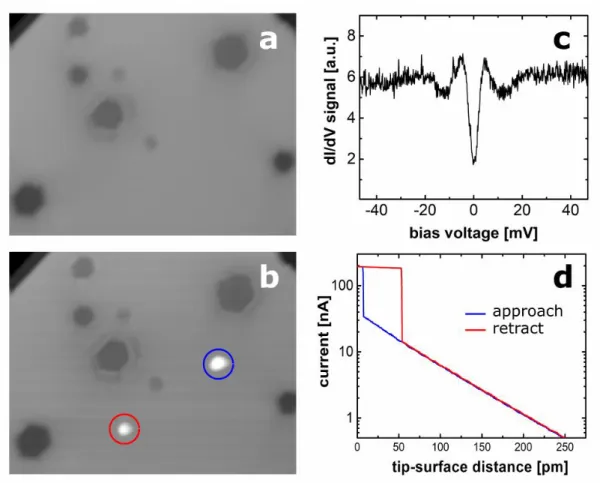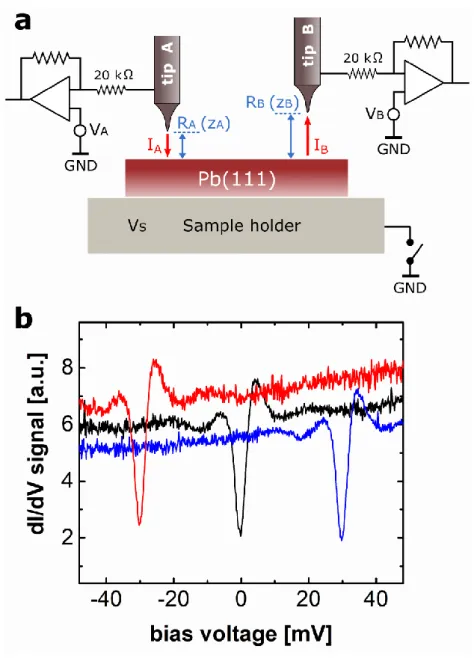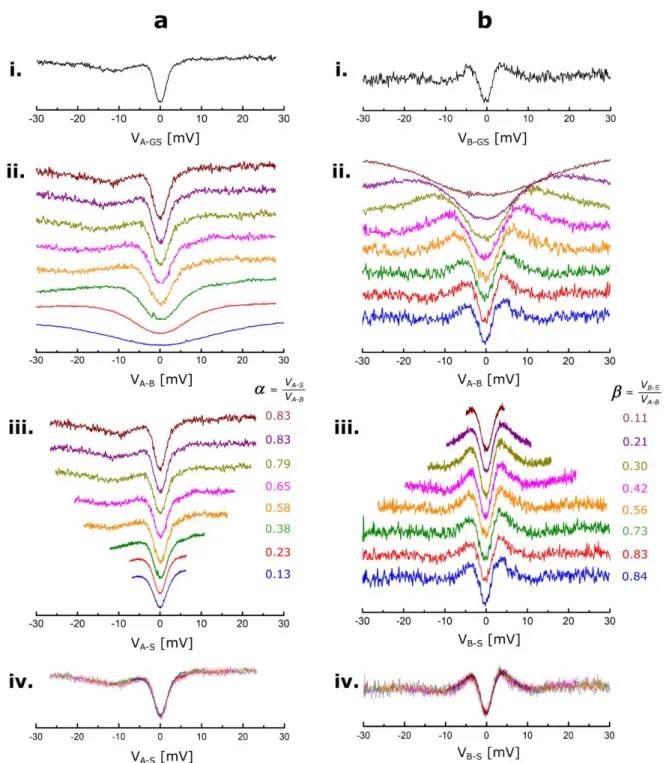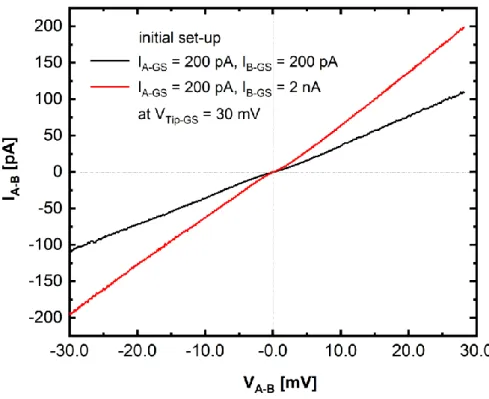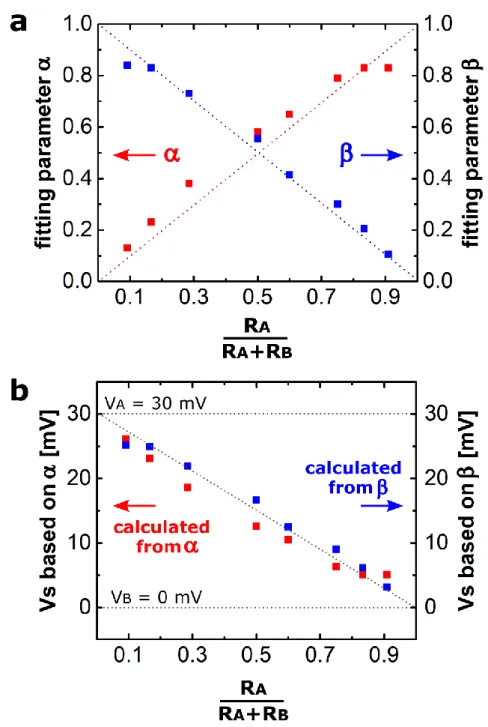HAL Id: hal-03004578
https://hal.archives-ouvertes.fr/hal-03004578
Submitted on 13 Nov 2020HAL is a multi-disciplinary open access archive for the deposit and dissemination of sci-entific research documents, whether they are pub-lished or not. The documents may come from teaching and research institutions in France or abroad, or from public or private research centers.
L’archive ouverte pluridisciplinaire HAL, est destinée au dépôt et à la diffusion de documents scientifiques de niveau recherche, publiés ou non, émanant des établissements d’enseignement et de recherche français ou étrangers, des laboratoires publics ou privés.
Low temperature two STM tip tunneling measurements
of a floating chemical potential Pb(111) surface
We -Hyo Soe, Corentin Durand, Christian Joachim
To cite this version:
We -Hyo Soe, Corentin Durand, Christian Joachim. Low temperature two STM tip tunneling measure-ments of a floating chemical potential Pb(111) surface. European Physical Journal: Applied Physics, EDP Sciences, 2019, 87 (3), pp.31001. �10.1051/epjap/2019190122�. �hal-03004578�
1
Low Temperature Two STM Tip Tunneling Measurements of a
Floating Chemical Potential Pb(111) Surface
We-Hyo Soe1,2,*, Corentin Durand1 and Christian Joachim1,2
1 CEMES, Université de Toulouse, CNRS, 29 Rue J. Marvig, BP 94347, 31055 Toulouse
Cedex, France
2 International Center for Materials Nanoarchitectonics (WPI-MANA), National Institute for
Materials Science (NIMS), Namiki, Tsukuba, Ibaraki 305-0044, Japan
2
Abstract. On a Pb(111) superconducting surface, low temperature dI/dV tunnelling spectra are
recorded between two scanning tunnelling microscopes (STM) metallic tips with the Pb(111) sample metallic support non-grounded. The tunnelling current intensity I passing between the 2 tips through the sample is controlled by changing one or both STM vacuum tunnelling junction resistances. The chemical potential of this floating Pb(111) surface depends on the normalized ratio between those two quantum resistances. When ungrounded, the Pb(111) sample chemical potential balances between those of the 2 STM tips while tuning their respective tip end atomic apex to Pb(111) surface distances with a picometer precision without any physical contact between the STM tips and the surface.
3
1 Introduction
In a multiple contact electrodes set–up fabricated on the surface of a conductive material to characterize, for example, its intrinsic electronic transport properties, the different chemical potentials of the source, drain and/or floating electrodes are governing the current intensities passing through the sample [1]. Current intensities also depend on the contact resistances (Ballistic, Ohmic, Schottky) between the electrodes and the sample, especially when the sample size is smaller than the electronic mean free path of the material [1,2]. The contact electrodes are usually fabricated using micro and nanofabrication techniques [3]. Their positioning onto the sample surface is fixed (one multiple contacts configuration per fabrication run) and located at best with a few nanometres precision on this surface [4,5]. The precision is generally less due to the lateral diffusion of the very last metal atoms during the electrodes metallization step [6] either using a resist, a shadow mask [7,8] or a dynamic stencil [9].
Recently, multi-probes scanning tunnelling microscopes (STM) have been developed to enable a movable and more precise way of positioning the contacting electrodes. Here and on the sample surface, the lateral and vertical positioning of the STM tip electrodes is controlled within a few nanometers. More important, the contact resistances can be adjusted using the STM tip-to-surface vertical distance [10-14]. Without touching physically the surface, it opens the way to control the elementary electron transfer processes from the tip end apex to the sample surface (or the reverse) at the origin of the measured tunnelling current intensity.
Such a tunnelling contact is obtained when the STM tip end atom is maintained further away from the surface uppermost atom than the van der Walls distances. There is no physical deformation of the surface nor chemical bond to the surface. In this case and when the sample is not grounded, its surface is set in an electronic floating configuration with still electrons able to be transferred from one STM tip to another through the surface. In this configuration explored below, there is a non-classical potential drop due to decoherence effects at each tip apex to surface vacuum tunnelling junction. This strictly non-invasive measurement configuration is to be found when the electronic orbitals overlap between the sample surface and the STM end atom tip apex are maintained as small as possible while conserving long range electron transfer events between the tips through the surface. This configuration is also to be found when measuring the intrinsic conductance of a surface atomic wire [15] or a molecular wire [16] without perturbing their molecular orbitals [17].
To reach this strictly non-invasive tunnelling measurement configuration, a new very stable low temperature (LT) ultra-high vacuum (UHV) four STM scanners instrument (LT-UHV 4-STM)
4
[18] is used to measure the chemical potential of an atomically clean UHV prepared Pb(111) sample in a 2 + 1 contacts configuration. The 2 contacts are non-invasive tunnelling contacts as defined above and the third one is a macroscopic very low ohmic contact resistance at the back of the Pb(111) sample. The first electrode (the source, Tip A) is one atom sharp STM tip apex of the LT-UHV 4-STM. It is not physically nor electronically touching the surface. Using an external voltage source, it is maintained at a well-controlled electronic chemical potential µ𝐴 =
𝐸𝐹 + 𝑒𝑉𝐴 where 𝐸𝐹 is the tip metal material electronic Fermi level. The second electrode (the drain, Tip B) is a second STM tip apex (Tip B) of the same instrument. It is also not touching the surface and set at a well-controlled chemical potential µ𝐵 = 𝐸𝐹 + 𝑒𝑉𝐵. The third electrode is static: the underlying stainless steel Pb(111) sample holder on the LT-UHV 4-STM. This holder can be automatically and in-situ connected to (or disconnected from) a well-defined macroscopic ground as discussed formally in [19]. When not grounded, the “lead-stainless steel bulk” chemical potential µ𝑆 is floating between µ𝐴 and µ𝐵. As measured in this paper, µ𝑆
depends critically on the atomic scale Tip A and Tip B vacuum tunnelling contacts resistance to the Pb(111) surface. We demonstrate how µ𝑆 can be tuned in real time by setting the two
STM tips distance from the Pb(111) surface with a few picometers precision on our LT-UHV 4-STM required to master those non-invasive tunnel contacts.
2 Preparation of the floating two tips surface measurements
The clean Pb(111) surface of the lead sample mounted on its stainless steel holder was prepared following a multiple cycles of Ar+ surface sputtering and 160 °C annealing in the UHV preparation chamber of our Scienta-Omicron low temperature LT-UHV 4-STM [18]. The Pb(111) sample was transferred in UHV onto the sample stage and cooled down to liquid helium (LHe) temperature, below the superconducting transition temperature of lead (Tc = 7.19 K). The superconducting Pb(111) surface was preferred to a standard non-superconducting metal surface to follow the µ𝑆 variations using the well characterized Pb(111) superconducting
gap observable in dI/dV curves.
A typical LT-UHV STM image recorded using one scanner of our LT-UHV 4-STM is presented in Fig.1a. The dark hexagonal features originate from the quantum well electronic states created between the topmost Pb(111) surface and the sub-surface Ar bubbles formed during the Pb(111) surface preparation [20]. The preparation of the atomic scale STM tip apex with a single end atom was performed by a soft indentation in the Pb(111) surface of each STM tip before the
5
measurements (Fig.1b). At LHe temperature, it certainly results in a wetting of the tungsten tip apex with a few Pb atoms. All our tunnelling junctions formed by this gentle indentation are still superconducting-vacuum-normal metal junctions, the lead layer thickness captured during the tip indentation remaining at the atomic scale. The dI/dV spectrum of such a junction is presented in Fig.1c with the Pb(111) sample macroscopically back grounded through the sample holder. It demonstrates a clear superconducting gap which is reproducible with all tips on the LT-UHV 4-STM and on any atomically flat terrace of the Pb(111) surface. According to this measurement, an effective 6 K tunnel junction temperature can be estimated [21].
Since the 4 STM tips of our multi-probes LT-UHV can be controlled and scanned independently on the same Pb(111) surface, Tip B was first set in a ballistic contact transport regime and Tip A in a tunnelling contact regime with the Pb(111) sample surface. To achieve this configuration, the distance 𝑧𝐵 between the end atom of the Tip B apex and the Pb(111) surface was first fine-tuned to reach one quantum of resistance (𝑅𝐵 = 12.9 kΩ). This was performed using the
current-distance characteristics 𝐼𝐵(𝑧𝐵 ) recorded by anticipation with the sample holder still grounded as presented in Fig. 1d, leading to a 3.45 eV apparent tunnel barrier height [22]. This 𝐼𝐵(𝑧𝐵 ) curve illustrates the stability of our instrument in mastering the tip apex end atom to surface distance > 0.06 nm with a precision better than 2 pm (see Ref. 18) for mastering a strictly non-invasive vacuum tunnelling contact per tip. Then, this holder was disconnected from the ground with a Tip A tunnelling junction resistance 𝑅𝐴 ≫ 12.9 kΩ. The fine-tuned
contact resistance of Tip B was preserved by freezing 𝑧𝐵, which is possible thanks to the stability of our LT-UHV 4-STM (lateral stability: < 0.9 nm per hour [18]). Its chemical potential µ𝐵 was controlled by shifting the virtual ground of its STM I-V convertor from zero to 𝑉𝐵= +/-30 mV (Fig. 2b). Since 𝑅𝐵 = 12.9 kΩ, this is also fixing the Pb(111) surface chemical potential
to µ𝐵 (see below). Tunnelling dI/dV spectra were recorded with Tip A still in a tunnelling contact junction mode on the Pb(111) surface. As presented in Fig. 2b, indeed a µ𝐵 change by +/-30 mV shifts the dI/dV spectra accordingly with no deformation. The Tip A to Tip B apex distance can be as large as 6 mm on our instrument with no voltage drop along the superconducting Pb(111) surface while scanning Tip A with an immobile Tip B. Such dI/dV recording certifies that the virtual ground on the Tip B STM electronics is working perfectly through the input transistors differential pair of its I-V convertor.
6
3 Two tips measurements in a sample floating mode
Starting from Tip A in tunnelling and Tip B in ballistic contact regimes, the distance 𝑧𝐵 between
Tip B apex and the Pb(111) surface was systematically varied to change the Tip B junction resistance from this ballistic to different tunnelling junction resistances. With 𝑉𝐴 and 𝑉𝐵 set to 30 mV and the sample holder grounded, the STM feedback loop current was first set at 𝐼𝐴 = 200 pA for Tip A and 𝐼𝐵= 2 nA for Tip B. Once 𝑧𝐴 and 𝑧𝐵 are stabilized, the feedback loop of
both STM’s are opened and the sample holder disconnected from the ground. A spectroscopic measurement is then performed by sweeping 𝑉𝐴, while 𝑉𝐵 is set to zero (µ𝐵 = 𝐸𝐹) through its
STM I-V convertor. At the end of a measure sequence, both tips and the sample are back to their initial set up and sample holder grounded with the feedback loops on. Then, the corresponding 𝑅𝐴 and 𝑅𝐵 tunnelling junction resistances are set to the next values by changing again the feedback loop current set points. As presented in Fig. 3, a set of measurements correspond to the Tip B current setting reduced measurement after measurement sequences from 2 nA to 200 pA in 8 set points (2 nA 1 nA, and down to 200 pA at intervals of 100 pA). When reaching 𝐼𝐵 = 200 pA, Tip A current was then increased from its initial 𝐼𝐴 = 200 pA up to 2 nA following an equivalent measurement sequence now on Tip A in 8 set points.
When the sample holder ground is disconnected, Tip B acts as a virtual ground. The tunnelling current flows from Tip A to Tip B through the Pb(111) sample with e(𝑉𝐴 – 𝑉𝐵) the Tip A to Tip B chemical potential difference. At each (𝐼𝐴 , 𝐼𝐵) combination of the feedback loops set points,
a d𝐼𝐴/d𝑉𝐴−𝐵 spectrum was recorded on Tip A and then a d𝐼𝐵/d𝑉𝐴−𝐵 on Tip B using a standard
lock-in technique on each junction. All dI/dV spectra shown in Fig. 3 were recorded in constant height mode and with no averaging. For reference, Fig. 3(a)i and 3(b)i present respectively the d𝐼𝐴/d𝑉𝐴−𝐺𝑆 and d𝐼𝐵/d𝑉𝐵−𝐺𝑆 characteristics recorded independently, both in a tunnelling contact,
just before disconnecting the sample holder ground. The details of the spectrum features are different from Tip A to Tip B because of different tip apex atomic scale configurations.
For the data set selectively presented Fig. 3ii to Fig. 3iv and with both junction bias set up at 30 mV, a pair of set point currents (𝐼𝐴 , 𝐼𝐵) corresponds here to a relative
𝑅𝐴
𝑅𝐴+𝑅𝐵 resistance ratio of
respectively 0.91, 0.83, 0.75, 0.60, 0.50, 0.29, 0.17, and 0.09. The dI/dV spectra were obtained between Tip A and Tip B while the µ𝑆sample holder is floating normally between µ𝐴 and µ𝐵 (see below). The spectrum recorded at the junction with the highest resistance, i.e., fixed at a larger tip apex to surface distance, shows an apparent superconducting gap close to the reference shown by Fig. 3i (for example, the topmost spectrum for Tip A 3(a)ii and the bottom
7
most spectrum for Tip B in 3(b)ii). On the contrary, spectra recorded from lower resistance junctions (smaller tip-sample distance) exhibit a progressively deformed dI/dV spectrum with a wider apparent superconducting gap.
4 Discussion
To understand this apparent distortion of the measured superconducting gap when the sample holder is not grounded, the conductance G = eI/(µ𝐴– µ𝐵) of the entire system constituted by the 2 tunnel junctions A, B and the Pb(111) sample, can be written [23]:
G = (e2/ħ) (𝑇𝐴𝐵+ 𝑇𝐴𝑆 𝑇𝐵𝑆
𝑇𝐴𝑆+𝑇𝐵𝑆 ) (1).
𝑇𝐴𝐵 is the phase coherent transport contribution giving the number of electrons per second
created by the source electrode Tip A, transferred through the tunnel barrier A, travelling in the sample between two A and B junctions without energy loss, and detected directly by the drain electrode Tip B via the tunnel junction B [19]. The second term in (1) is a phase decoherence and energy relaxation term [23] including also for a superconducting sample the copper pair breakdown process. Here, TAS (respectively TBS) is the transmission coefficient of the tunnelling
electrons between the source electrode Tip A (resp. Tip B) and the sample through the vacuum tunnel junction A (resp. B). For this path, the transferred electrons into the superconductor sample are creating Cooper pairs at µ𝑆 (i.e. losing the initial energy and phase). Those pairs are reaching the lead-stainless interface, are destructed (loosing also their phase and energy) and are absorbed by the stainless steel sample holder which is in a normal metallic state. When the sample holder is not grounded, it still acts like an electron reservoir [1,2]. Following [23], an effective chemical potential µ𝑆 can be defined for this floating reservoir leading from (1) to:
µ𝑆 = (𝑇𝐴𝑆.µ𝐴 + 𝑇𝐵𝑆. µ𝐵) / (𝑇𝐴𝑆+ 𝑇𝐵𝑆) (2)
At the drain electrode (Tip B) side, the detected electrons are created by the decomposition of Cooper pairs which are supplied by electrons coming both from A directly and indirectly from this holder reservoir. Notice that in the Fig. 3 presented measurement series, 𝑇𝐴𝐵 was at least experimentally one order of magnitude lower than TAS and TBS. This was confirmed by
8
measuring the 𝐼𝐴𝐵− 𝑉𝐴𝐵 charactistics in the floating mode leading to G in (1) and this for different feedback set-up of the Tip A and Tip B junctions (See Fig. 4).
After having used those quantum electron transfer processes through the Pb(111) surface and the bulk to get µ𝑆, it can be of interest to define an effective 𝑉𝑆 using the linear relation µ𝑆 = 𝐸𝐹 + 𝑒𝑉𝑆 indicative of the sample chemical potential shift in reference to the equilibrium 𝐸𝐹 (without electron transfer through the sample). Starting first from this effective 𝑉𝑆 definition
can also be considered as a reciprocal of the approach presented in [23]. Then, 𝑉𝐴 – 𝑉𝐵 can be written according to (2):
𝑉𝐴 – 𝑉𝐵 = (𝑉𝐴 – 𝑉𝑆) + (𝑉𝑆 – 𝑉𝐵) = (𝑉𝐴 – 𝑉𝐵) + (𝑉𝐴 – 𝑉𝐵) (3)
where = 𝑅𝐴
𝑅𝐴+𝑅𝐵, =
𝑅𝐵
𝑅𝐴+𝑅𝐵 and ideally + = 1. In Fig. 5a, the experimental values of and
were determined by progressively contracting (dilating) the voltage axis of the dI/dV curves presented in Fig. 3 until they matched the reference Pb(111) sample holder grounded dI/dV Fig. 3(a)i or 3(b)i spectra. The converse behavior of the spectra recorded at Tip A and Tip B results in an opposite variation of and with the resistance ratio. The crossing between the
α
andβ
curves does not occur exactly at 0.5. We believe that this is due to different tip apex end atomic scale structure between Tip A and Tip B. It leads to a small difference in the apparent tunnel barrier height estimated from the slope of the corresponding 𝐼𝐴(𝑧𝐴 ) and 𝐼𝐵(𝑧𝐵 ) curves alreadymeasured when the holder is grounded. Since the metal to metal contact between the back surface of the lead sample and the top surface of stainless steel sample holder is ohmic in our experiment, the lead sample and its holder are at the same µ𝑆 equilibrium chemical potential. As indicated above, we have also measured 𝑅𝐴 = (ħ/e2) × 𝑇𝐴𝑆-1 and 𝑅𝐵 = (ħ/e2) × 𝑇𝑆𝐵-1 independently as a function of Tip A and Tip B apex distance to the Pb(111) surface by recording their respective 𝐼𝐴(𝑧𝐴 ) and 𝐼𝐵(𝑧𝐵 ) characteristics when the holder was grounded.
Knowing 𝑅𝐴 and 𝑅𝐵 and following (3), we can determine the 𝑉𝑆 variations based on those data sets as presented in Fig. 5b. Notice that when Tip B is exactly at ballistic contact (𝑇𝑆𝐵 = 1 or 𝑅𝐵 = 12.9 kΩ) and 𝑇𝐴𝑆 << 1, then 𝑉𝑆 = 𝑉𝐵. This is consistent with the zero shift of the dI/dV
9
5 Conclusion
The floating chemical potential of a lead superconducting metallic sample have been determined at LHe temperature, by transferring electrons through the Pb(111) surface of this sample between 2 STM tips (the source and the drain electrodes) in a three electrodes configuration where the end atom apex atomic orbitals of each tip are not hybridized with the ones of the uppermost Pb(111) surface atoms. The source and drain vacuum tunneling junction resistances with the Pb(111) surface were controlled by tuning the tip apex end atom distance to the Pb(111) surface with a few picometers precision. The decoherence and relaxation effects coming from those vacuum tunneling junctions and the non-superconducting metallic support of the lead sample has been demonstrated. This support is playing the role of a third electrode. Not grounded, it can be considered as an electron reservoir, the chemical potential of which can be balanced quantum mechanically between the source and drain chemical potentials by a fine tuning of the source and drain atomic scale tunneling contact resistance to the Pb(111) surface.
Authors contribution statement
We-Hyo Soe carried out the majority of the experimental work and Christian Joachim of the measurement interpretation. All authors contributed to discussions and writing manuscript. The authors thanks to Takashi Uchihashi from MANA-NIMS for constructive discussion about surface superconductivity, to Erik Dujardin and David Martrou from PicoLab at GNS-CEMES for their support during this work.
10
References
1. M. Büttiker, Phys. Rev. B 33, 3020 (1986) 2. M. Büttiker, Phys. Rev. B 35, 4123 (1987)
3. R. Voss, R.B. Laibowitz and A.N. Broers, Appl. Phys. Lett. 37, 656 (1980) 4. S. Washburn, IBM J. Res. Develop. 32, 335 (1988)
5. R. de Piccioto, H.L. Stormer, L.N. Pfeiffer, K.W. Baldwin and K.W. West, Nature, 411, 51 (2001)
6. M. Fujimori, S. Hieke, Y. Tarada and T. Hashizume, Nanotechnology, 15, S333 (2004)
7. T.N. Tun, M.H.T. Lwin, H.H. Kim, N. Chandrasekar and C. Joachim, Nanotechnology, 18, 335301 (2007).
8. T. Ushihashi, U. Ramsperger, T. Nakayama and M. Aono, Jap. J. App. Phys. 47, 1797 (2008) 9. S. Egger, A. Ilie, Y. Fu, J. Chongsathien, D.J. Kang and M. E. Welland, Nano Lett. 5, 15 (2005)
10. C. Joachim, D. Martrou, M. Rezeq, C. Troadec, Deng Jie, N. Chandrasekhar and S. Gauthier, J. Phys. Cond. Mat. 22, 084025 (2010)
11. R. Thamankar, T. L. Yap, K. E. J. Goh, C. Troadec and C. Joachim, Appl. Phys. Lett. 103, 083106 (2013)
12. J. Baringhaus, M. Ruan, F. Edler, A. Tejeda, M. Sicot, A.T. Ibrahimi, A-Ping Li, Z. Jiang, E.H. Conrad, C. Berger, C. Tagenkamp and W. A. de Heer, Nature, 506, 349 (2014)
13. B. Voigtlander, V. Cherepanov, S. Korte, A. Leis, D. Cuma, S. Just and F. Lüpke, Rev. Sci. Inst. 89, 101101 (2018)
14. O. Kubo, Y. Shingaya, M. Nakaya, M. Aono and T. Nakayama, Appl. Phys. Lett. 88, 254101 (2006)
15. M. Kolmer, P. Brandimarte, J. Lis, R. Zuzak, S. Godlewski, H. Kawai, A. Garcia-Lekue, N. Lorente, T. Frederiksen, C. Joachim, D. Sanchez-Portal and M. Szymonski, Nature Comm. 10, 1573 (2019).
16. L. Lafferentz, F. Ample, H. Yu, S. Hetch, C. Joachim and L. Grill, Science, 323, 1193 (2009)
11
17. C. Joachim, J. K. Gimzewski, R. R. Schlittler and C. Chavy, Phys. Rev. Lett. 74, 2102 (1995)
18. J. Yang, D. Sordes, M. Kolmer, D. Martrou and C. Joachim, Eur. Phys. J. Appl. Phys. 73, 10702 (2016)
19. J.M. Byers and M. E. Flatté, Phys. Rev. Lett. 74, 306 (1995)
20. M. Schmid, W. Hebenstreit, P. Varga, and S. Crampin Phys. Rev. Lett. 76, 2298 (1996) 21. S.H. Pan, E.W. Hudson and J.C. Davis, Appl. Phys. Lett. 73, 2992 (1998)
22. G. Binnig, H. Rohrer, Ch. Gerber and E. Weibel, Phys. Rev. Lett. 49, 57 (1982) 23. M. Büttiker, IBM J. Res. Develop. 32, 317 (1988)
12
Fig. 1. Typical constant current Pb(111) surface images (a) before and (b) after constructing
one after the other two quantum point contacts where atomic droplets have been produced while retracting the tip apex (see Fig. 1d for Tip B) with a Pb single atom (red circle) and a Pb dimer (blue circle). The hexagonal features in (a) and (b) are Ar-bubbles created during sample cleaning process in the vicinity of surface [20]. (c) Tip A dI/dV spectrum showing the superconducting gap characteristics of a superconductor-vacuum-metal junction. Notice that the bias voltage was ramped up by of steps 0.1 mV per 0.1 s for all measurements presented in this paper to avoid any low pass filter effect. (d) Two single shot current distance characteristics 𝐼(𝑧) recorded on Tip B to determine the 𝑧𝐵 tip apex to surface relative distance to reach the 12.9 k quantum contact resistance. At this quantum contact, Tip B gives 𝐼𝐵 = 183 nA for 𝑉𝐵
= 6 mV i.e. an 𝑅𝐵 = 32.8 K junction resistance (12.9 k + a very low noise 20 k metallic
resistance in series). (a) and (b) images STM: I = 10 pA, V = 30 mV, images size: 40 nm x 30 nm. Equivalent images for Tip A and Tip B. The single one shot𝐼𝐵 = 𝐼𝐵(𝑧𝐵 ) were recorded in 10 s with the corresponding STM B feedback loop frozen. Multiple single shot I(z) characteristics were recorded for Tip A and Tip B. They present all the same slope (work-function). Only the jump to contact is changing from curve to curve with a z shift below 50 pm.
13
Fig. 2. (a) The two STM tip measurement electrical circuit diagram used on the Pb(111) surface
with its 2 virtual ground I-V convertors and the back ground controllable switch connected to the sample holder. The 𝑉𝑆 sample holder is defined using µ𝑆 = 𝐸𝐹 + 𝑒𝑉𝑆. (b) Three “one shot”
dI/dV spectra recorded on Tip A while the far away Tip B is in atomic point contact with the Pb(111) surface to control the sample chemical potential from its surface. Tip B potential is 𝑉𝐵 = 0.0 mV (black), 𝑉𝐵 = + 30 mV (blue) and 𝑉𝐵 = - 30 mV (red). Tip A was stabilized in a tunnelling regime with its STM Feed-back loop set up 𝐼𝐴 = 200 pA, for 𝑉𝐴 = 30 mV.
14
Fig. 3. A double selective series (a)ii and (b)ii of dI/dV spectra recorded on a Pb(111) sample
non grounded when both STM Tip A and Tip B are in tunnelling conditions. For reference, the (a)i and (b)i spectra have been recorded on Tip A and Tip B with the sample grounded. The and parameters are obtained by fitting the (a)ii and (b)ii spectra to the (a)i and (b)i dI/dV spectra recorded independently on the Tip A and Tip B dedicated lock-in when the sample was grounded. This fitting leads to the series (a)iii and (b)iii also perfectly superposed on (a)iv and (b)iv. VA-S = (𝑉𝐴 – 𝑉𝑆) the voltage difference between Tip A and the sample holder floating (see
Fig. 2a), VB-S = (𝑉𝑆 – 𝑉𝐵) between Tip B and the sample holder floating and VA-B = (𝑉𝐴 – 𝑉𝐵)
between Tip A and Tip B. VA-GS and VB-GS are the tip A and Tip B bias voltage when the
15
Fig. 4: Two examples of a direct floating 𝐼𝐴𝐵− 𝑉𝐴𝐵 characteristics recorded with the 2 initial
set-up indicated while the sample was grounded. After setting up Tip A and Tip B distances to the Pb(111) surface, the sample was ungrounded. For this set up and for example in the symmetric set-up case 𝐼𝐴−𝐺𝑆 = 200 pA, 𝐼𝐵−𝐺𝑆 = 200 pA at 30 mV, it comes for the direct to the ground 𝑇𝐴𝑆 = 0.8613 x 10-4 (for sample grounded) and 𝑇𝐵𝑆 = 0.8613 x 10-4 (for sample grounded). The total transmission coefficient (leading to G in Eq. (1) via the Landauer formula) is T = 0.4737 x 10-4 leading to 𝑇𝐴𝐵 < 0.043 x 10-4 (sample not grounded).
16
Fig. 5. (a) Variation of the experimental and obtained in (3) as a function of the 𝑅𝐴
𝑅𝐴+𝑅𝐵 ratio
measured independently with the sample holder grounded. From the Fig. 3 dI/dV spectra series, and were obtained going from the Fig. 3(a)ii and 3(b)ii series to the Fig. 3(a)iii and Fig. 3(b)iii series respectively. (b) For a set of dI/dV measurements with 𝑉𝐴 = 30 mV and 𝑉𝐵 = 0.0 mV, 𝑉𝑆 is obtained from (3) using the corresponding experimental and values as a function
of the 𝑅𝐴
𝑅𝐴+𝑅𝐵 ratio. (Each
𝑅𝐴
𝑅𝐴+𝑅𝐵 data point is corresponding to a 10 pm relative tip height
